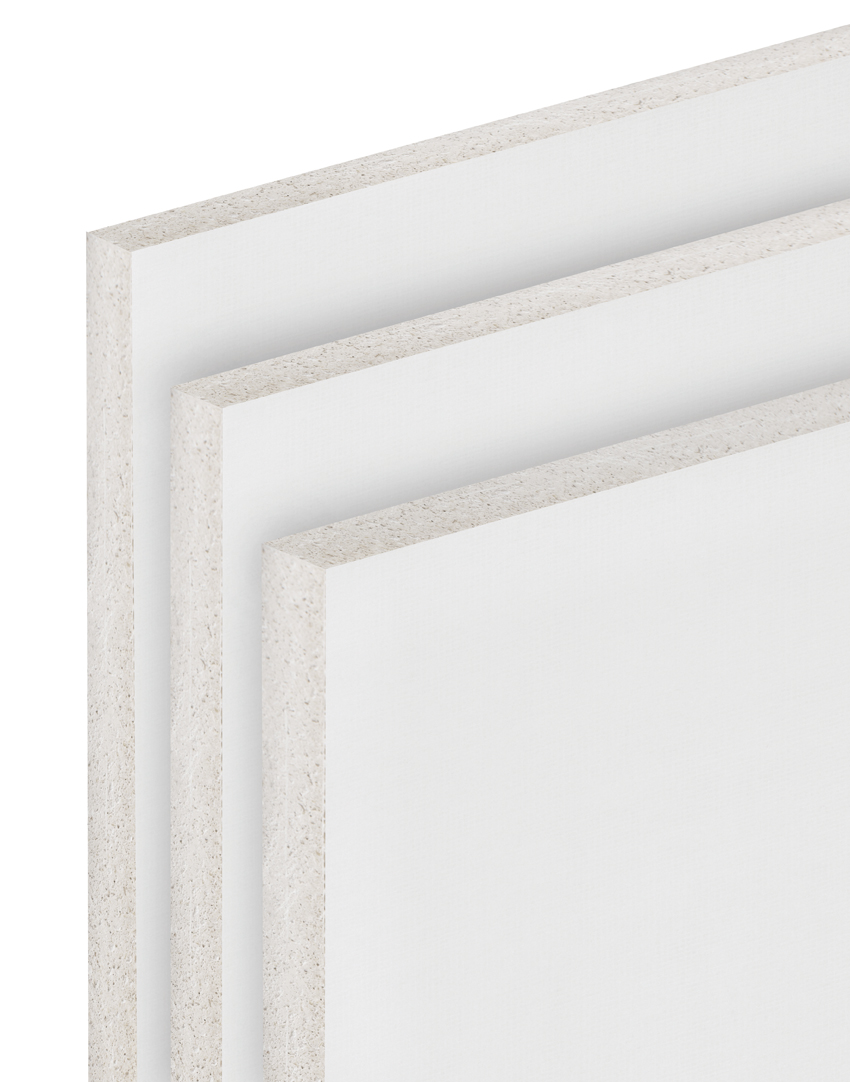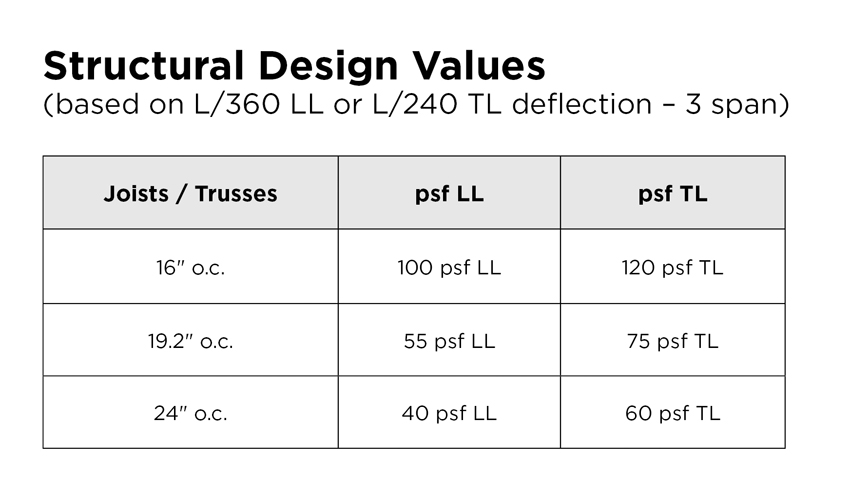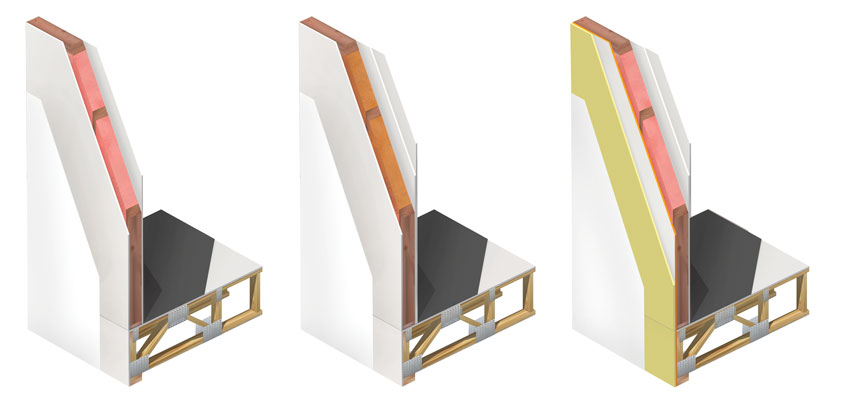Magnesium Oxide (MgO) Floor and Wall Panels for Multifamily Buildings
Physical Properties
To be appropriate for use in construction, boards for subflooring and wall sheathing need to be manufactured with some familiar physical properties allowing them to be integrated into the rest of the building assemblies. Along those lines, manufacturers of MgO boards commonly provide products within the following physical parameters:
- Panel size: The most typical size for any construction board product is a nominal 4 feet by 8 feet, and MgO boards are readily available in that size. Some high-quality manufacturers also offer longer length panels in nominal 4-feet by 9-feet and 4-feet by 10-feet sheets.
- Thickness: The thickness of a panel is usually a direct determinant of both the strength and weight of the product. Recognizing that there may be times when MgO is used alone or in combination with other materials, it is offered in different nominal thicknesses of 3⁄4 inch, 5⁄8 inch, or 1⁄2 inch.
- Weight: As noted, this can vary; but for a nominal 3⁄4-inch-thick sheet, the weight of MgO panels are approximately 4.5 pounds per square foot.

MgO sheathing panels are typically available in nominal 4 feet b by 8 feet, 4 feet by 9 feet, and 4 feet by 10 feet sizes. Though thickness may vary between brand, it is typical to see nominal 3⁄4-inch, 5⁄8-inch, and 1⁄2-inch product.
- Edge profile: There is no need for a gap between MgO boards as there is for other panel products. Therefore, the edges can be butted directly up against one another using a straight edge profile. Single-layer subfloor applications require edge support per IBC/IRC, so a tongue-and-groove option may also be available.
Allowable Uniform Floor Loading
MgO panels used for subflooring are intended to be used in one of two ways.
- MgO underlayment: One application of MgO in a floor assembly is to use it on top of a structural OSB subfloor panel. The MgO in this case would be a non-structural application as the OSB layer is acting as the structural element. The MgO underlayment is essentially acting as a replacement for poured gypsum underlayment to add better sound performance and assist in fire resistance.
- Single layer: At least one manufacturer is pursuing a product that will allow for MgO to be used as a standalone subfloor material ready to receive finish flooring. Not all MgO products are capable of this, however, so it is very important to verify any structural information with specific manufacturers. Standard structural analyses for subflooring is based on deflection value limits of L/360 for live loads or L/240 total load. The assumption is made that standard common practice is followed whereby the long end of the panels are installed perpendicularly across at least three floor supports (joists, trusses, etc.) In these circumstances, the typical residential structural floor code requirement of 40 psf live load (60 psf total load) needs to be met. At least one ¾-inch-thick product has been tested to achieve that level of uniform loading when the floor supports are spaced at 24 inches on center. For conditions where the loading requirements are higher, a version of the same product has been shown to support up to 100 psf live load (120 psf total load) with floor supports spaced at 16 inches on center.

Structural design values shown are based on one selected MgO panel. Structural design values will vary between different products. Always consult the manufacturer for product-specific information.
Suitability for Construction Types
Multifamily buildings are commonly constructed based on different categorized construction types defined in the International Building Code (IBC). Types I and II construction are commonly required for high-rise and mixed-use buildings and typically do not allow wood members. Instead they require fire-resistive or noncombustible materials. While MgO boards may be appropriate for use in these situations, thus far their use has not been common here since other materials such as fire-protected steel, concrete, and gypsum board tend to dominate these construction types. The fire resistance and other characteristics of MgO boards are such that they may be well suited for certain installations in Types I and II buildings and architects are certainly encouraged to consider their use where appropriate.
In cases where wood is allowed, however, MgO boards, particularly when used in conjunction with OSB subflooring, are seen as a very appropriate material choice. In that regard they are very appropriate for use in Types III, IV, and V construction which are described more fully as follows:
- Type III: The code refers to this as “ordinary” construction since it was historically a very common way to build using brick or CMU exterior walls and wooden interior framing. Buildings of this type are still built as new construction, but many older existing buildings of this type are commonly being renovated into loft style apartments or other multifamily housing. This is particularly true in older urban areas where warehouse and industrial buildings were commonly constructed this way. When seeking the appropriate fire-resistance ratings for this type of construction, there are one of two conditions that may apply based on other code compliance factors related to building use, size, fire areas, etc.:
- Type III-A: Protected Combustible requiring 2-hour rated exterior walls (with some specific exceptions), 1-hour rated structural frame and 1-hour floor/ceiling/roof protection
- Type III-B: Unprotected Combustible requiring 2-hour exterior walls (also with some specific exceptions) and no fire resistance for the structural frame, floors, ceilings, or roofs.
- Type IV: This is referred to as heavy timber construction and, while historically has been thought of as “post and beam” solid wood framing, there is a current resurgence in this construction type using engineered and laminated heavy wood products. This approach is seen as more sustainable and with less embodied energy than steel and concrete and has become popular for new low to mid-rise construction of multifamily and mixed-use buildings. In this construction type, 2-hour rated exterior walls (with some specific exceptions) and a 1-hour rated structural frame or heavy timber frame are required. It also includes heavy timber floor/ceiling/roof assemblies. In these cases, the heavy or laminated timbers are shown to achieve fire resistance by maintaining the minimum required structural strength after being exposed to fire for the determined time and, while exhibiting signs of charring, remains structurally intact due to its total mass.
- Type V: This is common wood stud frame construction used in many different types of low-rise residential construction. There are two subcategories here:
- Type V-A: Protected Wood Frame is what is commonly used in the construction of newer apartment buildings with no exposed wood visible. It requires 1-hour fire-rated exterior walls, 1-hour fire-rated structural frame and 1-hour fire-rated floor/ceiling/roof.
- Type V-B: Unprotected Wood Frame is commonly used in single-family/two-family homes and garages but is not typically allowed in multifamily (three or more dwelling units in a building). Often, exposed or unprotected wood is involved so there is no fire-resistance requirement.

Categorized construction types as defined in the International Building Code (IBC) with associated fire ratings.
MgO board products are suitable for any of these construction types and can add to the fire resistance of the assemblies in which they are used. They are appealing to construction contractors since they can be cut and installed using common carpentry tools making it very similar to working with other wood products on the project.









